
Original price was: €290.00.€169.99Current price is: €169.99.
Korg Volca Semi-Modular Synthesizer VOLCAMODULAR Price comparison
Korg Volca Semi-Modular Synthesizer VOLCAMODULAR Price History
Korg Volca Semi-Modular Synthesizer VOLCAMODULAR Description
Korg Volca Semi-Modular Synthesizer VOLCAMODULAR – A Versatile Music Maker
Unlock your musical creativity with the Korg Volca Semi-Modular Synthesizer VOLCAMODULAR. This compact and powerful synth is designed for musicians and sound designers seeking flexibility and innovation in their soundscapes. Ideal for both beginners and seasoned pros, the VOLCAMODULAR offers an exciting leap into the world of synths. Explore the sonic possibilities that this compact device has to offer, from lush pads to dynamic beats all in an ultra-portable format.
Key Features and Benefits
- Compact and Lightweight: Weighing just 1.8 pounds and measuring 7.6 x 4.53 x 0.3 inches, the Korg Volca Semi-Modular Synthesizer is easy to travel with, making it an excellent choice for live performances and studio sessions.
- 16-Keyboard Notes: With 16 responsive keys, you can easily play melodies and chords. This feature is perfect for improvisation and composition, allowing for rich musical exploration.
- Battery Powered: Powered by 6 AA alkaline batteries (included), this synth offers the freedom to create anywhere without the hassle of searching for an outlet.
- USB Connectivity: With USB hardware interface compatibility, connecting to your computer for music production is seamless. Perfect for integrating into your existing setup!
- Durable Metal Body: Constructed with a robust metal body, the VOLCAMODULAR is built to withstand the rigors of musical performance and regular use.
- Multi-Coloured Design: The vibrant design not only stands out aesthetically but also enhances your studio environment, reflecting the vibrant sounds you can create.
Price Comparison Across Different Suppliers
When seeking the best deal for the Korg Volca Semi-Modular Synthesizer, it is crucial to compare prices across various platforms. For instance, you may find prices ranging from $139.99 to $159.99 depending on the retailer. Check out our comprehensive price comparison feature, where you can track real-time prices and find the most affordable option tailored to your needs.
Insights from the 6-Month Price History Chart
Our detailed price history chart for the Korg Volca SEMI-MODULAR shows a slight decline in price over the past six months. This trend indicates an overall decrease in price, with sporadic promotions leading to lower price points during holiday sales. Staying informed about these trends can help you make a savvy purchase decision.
Customer Reviews at a Glance
Users are raving about the Korg Volca Semi-Modular Synthesizer! Here’s a summary of key points from the customer reviews:
- Innovative Sound Creation: Many users highlight the expansive range of sounds this synthesizer can produce, allowing for both traditional and avant-garde musical pieces.
- Easy to Use: Beginners appreciate how user-friendly the synthesizer is. The intuitive layout enables quick understanding and allows for fast learning curves.
- Robust Build Quality: Customers are particularly impressed by the synth’s durability. The metal construction ensures it withstands extensive use.
- Battery Life: Although most users enjoy the portability, some have noted that battery life can drain quickly depending on usage patterns, recommending recharging options for longer sessions.
Engaging Reviews and Unboxing Videos
For those who want a closer look at the Korg Volca SEMI-MODULAR, numerous unboxing and review videos are available on YouTube. These creators showcase the distinctive features live, demonstrating the synthesizer’s capabilities in real-time. Watching these videos can provide additional insights into how the synthesizer performs in various settings, which may help enhance your purchase decision.
Why Choose Korg Volca SEMI-MODULAR Synthesizer?
The Korg Volca Semi-Modular Synthesizer VOLCAMODULAR is not merely an instrument; it’s a gateway to endless creativity. Its compact size and impressive features make it a must-have for musicians of all levels. Whether you are looking for a reliable tool for live performances or a versatile instrument to play in the studio, this synth gives you everything you need.
Don’t miss out on this incredible synthesizer and the opportunity to elevate your music. With competitive prices and a wealth of features designed for today’s musicians, the Korg Volca SEMI-MODULAR Synthesizer is an obvious choice!
Compare prices now!
Korg Volca Semi-Modular Synthesizer VOLCAMODULAR Specification
Specification: Korg Volca Semi-Modular Synthesizer VOLCAMODULAR
|
Korg Volca Semi-Modular Synthesizer VOLCAMODULAR Reviews (9)
9 reviews for Korg Volca Semi-Modular Synthesizer VOLCAMODULAR
Only logged in customers who have purchased this product may leave a review.

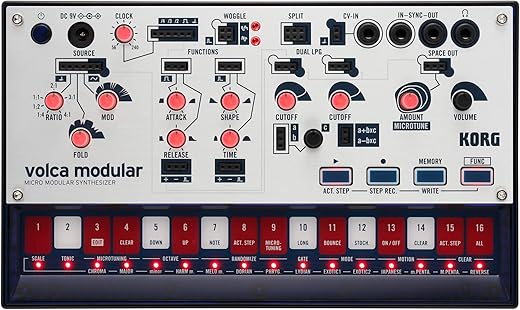
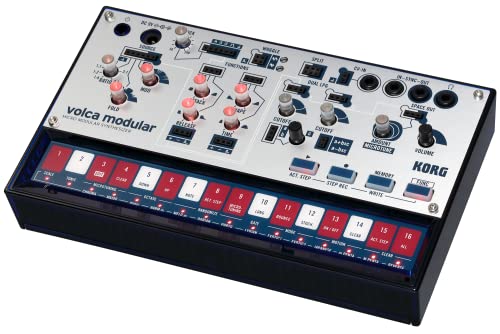
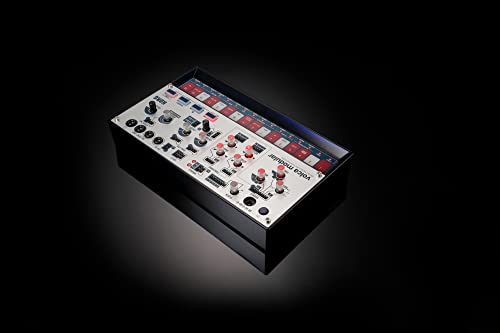
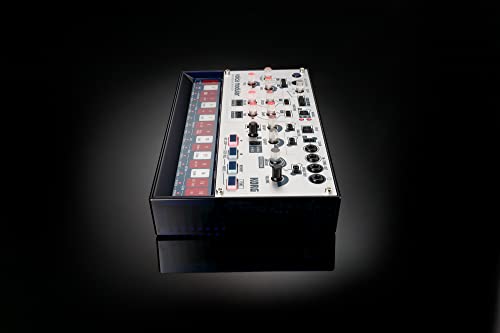
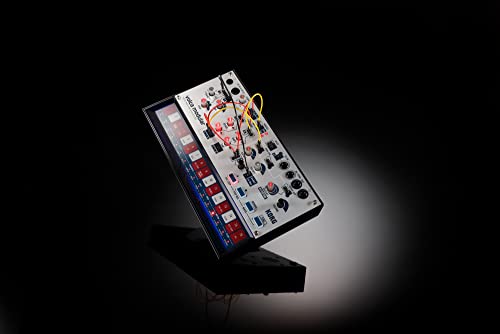






J.R. –
Pick it up and turn it on, it works, done, no connections needed. Yes, plug it in for better sound but the quality is of that sound is excellent. Sure, plug in a midi controller keyboard if you want. Go get a power adapter if you want. I just like to pick it up and use it immediately and create. Record, engineer, produce later. 🙂 Received very quickly.
ValentínMX –
Muy entretenido, buena relación calidad precio muy recomendado, quizá para presentaciones en vivo queda corto pero por el precio no hay quejas
Alma –
Sonido ácido en diseño compacto. Todas las características de un Volca: portátil, opción a baterías o corriente, secuenciador y (hay que decirlo) una bocina mediocre, pero ¿realmente quién usa la bocina para sus grabaciones? Muy divertido.
J.R. –
This was an impulse buy on Amazon Warehouse (AW) on a bitterly cold night in early February, an evening when I had had a few too many glasses of wine. I was vaguely aware of the Korg Volca series, in that I had seen a few negative or neutral comments about them on various music forums, but I hadn’t listened to any audio demos or watched any YouTube demonstration videos. Honestly, these tiny boxes had never appealed, as I like my synths with keys or something I can put in a rack and MIDI up to my rig. So when this popped up on AW in a “Used-Acceptable condition for what seemed to be nearly 50% off the retail price, I thought, well, if I don’t like it, I can sell it on for a profit.
I’m glad I did. I love this little box, and it looked absolutely brand new in the box when it arrived. Go figure. I like it more than my Pro-1 monosynth — I think the Volca Bass sounds better than most of my keyboards, with the exception of my Korg Radias. I mean to say, the Volca Bass is fat sounding, and oh!!! it has that distorted squeal that is very similar to a Roland TB-303 (or the Behringer clone). The filter resonance (peak knob) on this wee thing self-oscillates, so if you’re looking to do a bit of Daft Punk or Chemical Brothers-style late 90s and early 00s techno work, this little guy can do it, and do it very nicely.
Let’s get the cons out of the way:
The speaker is rubbish. I get why Korg put it there, but the speaker doesn’t have the range to actually hear what all the glorious goodness this synth can make. Tip: Use headphones if you’re going portable with this. Otherwise, hook it up to your mixer / monitoring system / amp.
The MIDI implementation is good, but you can’t modulate the filter via MIDI. What???!!! Why not, Korg? What are you thinking? Sigh… So, you must use the Volca Bass’s filter knob in real-time. Also, no MIDI out, but it is possible to modify the unit so that it can do MIDI out, so at least there’s that option for the hardcore modders.
Pattern storage is limited to 8 memory slots. You will use those up quickly, and then you’ll have to decide on which patterns to get rid of for later sessions. Also, there is no pattern chaining, so you must manually change patterns in real time, and you will need to do that in perfect sync as there is also no “wait to change pattern” functionality. If you’re sequencing a pattern, know that the filter knob adjustments do not get recorded. The octave knob’s movements will be recorded, however. On the other hand, it is possible to create 24 patterns when in individual three-osc mode, and with a bit of clever muting, you can probably do quite a bit with that.
The smaller, clear knobs … it’s sometimes difficult to see what their positions are. Also, when I reach for the tempo or the EG attack knobs at the top center/left of the unit, I often accidentally brush the big filter knob.
No noise oscillator… that’s a shame. But not a deal breaker…
So them’s me cons. On the the pros:
Three very stable analog VCOs (digitally tuned for stability, but these bad boys are definitely analog oscillators), any of which can be a Saw or Square wave. You have the options of three independent VCOs, two stacked together, or all three stacked together. There is also a tuning knob for each VCO, so you’re able to create a very thick and fat super saw sound. Note range can be adjusted per voice but only if you are sequencing a pattern. Otherwise, all three VCOs will change depending on where the octave knob is set.
The playing surface (ribbon?) is really responsive to touch and it’s fun to play and slide around on it, but it is important to note that the playing surface is not velocity sensitive. The Volca Bass responds to velocity when connected to MIDI controller, though. Keep that in mind if you want to get the most you can out of this tiny box of joy. It took me a few minutes to work out what the deal was with the black and gold “keys.” Tip: The gold keys are the black keys on a keyboard. The rest are the white keys. The lowest note on the surface is an “A”. Maybe an “E” would have been better, which is the lowest note on a bass guitar, but from keyboard perspective I suppose it makes sense (an 88-key keyboard’s first note is an A.)
The filter on this insanely good. I read somewhere that it’s based on a Korg 700s filter. I dunno if it is or not. And I don’t care. I really like a lot.
The envelope seems limited, but it actually has two modes and it is perfectly serviceable. One mode with no sustain segment, just an attack and delay, which is superb for punchy bass tones, and the second mode is with a sustain feature, which is great for more synthy sounds and self-oscillating the filter rez. These modes are switched by holding down the function button and pressing the number 11 key marked Sustain.
Pattern sequencing is quick, if not a bit imprecise when doing it in real time. There is some sort of quantization going on, which can be distressing if your timing is off. I much prefer to sequence a pattern in Step Rec mode. Speaking of modes, the Active Step mode is useful and fun.
At the moment, I tend to use a Beat Step Pro to sequence more complex patterns. Other times, I will set up a zone on my workstation to play the Volca Bass via MIDI in real time. I’ll even swipe at the playing surface from time to time when playing other synths. You’ll definitely want to put some effects in the signal chain, such as pedals or some other multi-fx unit, as the dry sound may be a bit in your face. But even dry, it can sit in a mix at low volumes.
All in all, I’m really impressed by the sound of the Volca Bass. I had no idea that I was missing this in my life, and I’m glad I bought it. I’m now considering selling my Pro-1, as I have had that turned off since the beginning of February when the Volca arrived and I don’t need two monosynths which cover the same sonic terrority.
For its size, it’s a little powerhouse in a tiny, tiny box. Could the UI (knobs), memory storage and MIDI implementation be improved? Sure, those could be better, but if you can snag one of these for $100 or less, it’s definitely worth it.
NOCATSNET –
This thing can have a BIG sound when you want it to. Crisp instruments and crunchy lo-fi PCM samples for the non-drum sounds. The drums have adjustable parameters. There’s motion recording. The touch-keys are very responsive. The knobs are tiny and painful to twiddle too much, but easily replaced with other Korg instrument knobs.
1/8″ jacks and only a midi-in are pretty annoying. Be ready with a converter or a 1/4″-1/8″. CV sync makes it incorporate nicely with other analog instruments. Thing is small and has an incredible battery life. I like to take it to work and jam on my breaks. Time will fly very quickly if you do this, so work quick.
The snare sucks. It’s really bad, but it can be a good third tom at least. It was because they forgot to put a capacitor in a certain spot on the PCB and the quality control guy who approved this was probably new and didn’t know analog snares were not supposed to sound like they were coming out of an 80s game console. There are resources online on exactly how to fix the snare by soldering the appropriate capacitor onto the appropriate spot on the PCB. It takes 10-20 minutes and a bit of bravery (if you’ve never soldered before).
Once modded, the snare sounds like a proper analog snare and really elevates the instrument to astronomical levels for its price point.
ant3nee –
I’m starting to collect these things like special edition Lego sets. It’s really fun to experiment with sounds. And create your own unique sounds you can capture to another device turn it into an instrument.
Huerell –
Korg’s Volca series is great, but it would probably be helpful to know what you’re getting into ahead of time before purchasing. While there’s a lot of videos on YouTube, and some busy topics on Reddit discussing the merits of these machines, I think I fit pretty accurately the target audience for the series to help speak on whether or not they might be right for you: I’m an amateur to synthesis and have minimal space for gear, a low budget, and an affinity for low-fi sounds.
That being said, I started with the Bass about a year and a half ago and admittedly didn’t really understand the thing, or how to use it in my workflow that at the time was primarily just clicking around in the DAW. After jumping over that hurdle and learning the various functions and controls, the thing really opened up. While it’s certainly got a tinny/metallic sound to it and is by no means your classic acid machine, the thing really screams and can make some great sounds. Granted, I don’t have years of experience with higher-end synthesizers to compare against, but that leads into my next point, which is that these machines are just fun, especially for someone starting out working with hardware.
I’ve seen complaints about them being ‘toys’, or limited in what you can do with them, and while I won’t argue the merits of that based on some folks’ perspectives, the small, portable nature of them makes them a non-invasive addition to a small space and perfect for picking up and messing around outside of the desk or studio environment. The price tag encourages buying them over time, and since getting the Bass, I’ve added the Beats, FM, and Keys to the mix. They each have their own quirks and limitations that encourage creativity. As well, they’re powerful enough to be useful, and rather than being overwhelming machines (a bit like the Microbrute is for me as still-an-amature), they’re in most respects easy to learn. The FM’s a bit of it’s own story though, as FM synthesis is complicated by nature.
I’m hesitant to purchase the Sample, simply due to the lack of an audio in. Maybe the iOS app is convenient and easy to use, but it still adds an extra layer to getting sounds on the machine. Which brings me to another point: if you’re considering either the Beats or the Sample, you might look first for a used ES-1 or ER-1. They’re roughly the same price, but a bit more versatile (although bigger), and at least in comparing the ER-1 to the Beats, sound considerably better (the Beats snare issue is annoying, but not a total deal breaker if the other pros outweigh that con).
In summary, I think these are really great, affordable little machines. Without the hassle of buying old buggy hardware, you get some new portable things with a lot of potential. If you’re looking for machines with ‘recordability’, though, these probably fall more in the jam-box or accent-to-other-machines category.
Have fun!
Retired golfer/bounty hunter –
O Korg Volca Bass supera em muito aquilo que se espera de uma máquina de baixos sintetizados analógicos. Com três osciladores e outros recursos , é possível compor melodias expressivas e fazer sobreposições harmônicas. Excelente! Fica com um som ainda mais bonito se for ligado em uma mesa com reverb e delay para ambientação “espacial”.
O ponto fraco é o auto-falante interno. Muito ruim, mas é melhor do que nada se você estiver fissurado para trabalhar com a máquina e não tiver bons fones de ouvido.
Marcelo Miranda Guimarães –
It’s actually really good. The overdrive effect sucks tho. It’s just another volume button and does zero crunch. I removed a star for that and another one because my device was open box and not new. It had disgusting greasy fingerprint smears all over the keyboard that I needed to clean off which is really gross. I got it on sale though and I’m noticing that Amazon sales on “new” products seem to come with some kind of false advertising like this very often… I have a tube screamer emulator pedal that I use on this if I’d like that sort of distortion and this little tube emulator mono synth is actually not bad. It’s a nice thick sound and my son who’s into techno just loves it as well. Call me crazy, but I wish all monosynths came with this kind of keyboard.. the finger wiggle slide convenience allows for some superior funky expression to normal more expensive keys and it’s also way more responsive for fast playing. I’d actually buy korg midrange if it came with a keyboard like this instead of icky cheap clunky “piano” keys. The frequency can reach mid range so it is use-able for leads I guess but I just use it for bass. It’s a thicker sound to the volca bass and I completely prefer this sound to that.